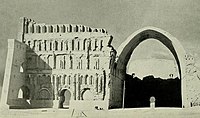Chaldean Catholic Eparchy of Salmas
For much of the nineteenth and twentieth centuries the district of Salmas in northwest Iran was an archdiocese of the Chaldean Catholic Church, now a part of the Chaldean Catholic Archeparchy of Urmyā.
Early history
In the
The church of the village of Chara in the Salmas district was built in 1360 at the expense of Mar Sliba, probably the bishop of Salmas.[1] The name Sliba was taken at a later period by the bishops of Jilu, a district with which Salmas was linked in the sixteenth century.
The Salmas district was inhabited by both Nestorian and
Catholic and Nestorian rivalry in the Salmas district
An unnamed bishop of Salmas was one of only three remaining
The patriarch Shemʿon IX Denha was earlier metropolitan of 'Salmas,
A metropolitan of Salmas named Joseph was one of the signatories of a letter of 1580 from Shemʿon IX Denha to pope Gregory XIII, and was presumably consecrated by his predecessor shortly after he became patriarch.[2] A metropolitan Joseph of Salmas is also mentioned in the report of 1607.[3]
The bishop ʿAbdishoʿ ('Servijesus') of Salmas ('Salmi') is listed among the hierarchy of Eliya VII (1591-1617) in the report of 1610, together with a bishop Ishoʿyahb 'of the land of Persia', dependent on the patriarch Shemʿon X.[4]
Ishoʿyahb, 'archbishop of Persia', was one of the bishops addressed in a letter of Peter Strozza of 1614, and may have been a bishop of Salmas, as the name later became traditional.[5]
A
The Salmas district came under strong Chaldean influence at the end of the sixteenth and the first half of the seventeenth century, when Salmas was the seat of the patriarchs Shemʿon IX Denha (1580–1600) and Shemʿon X (1600–38). According to Fiey, Shemʿon XI (1638–56), Shemʿon XII (1656–62) and Shemʿon XIII Denha (1662–1700) also spent most of their time at Salmas.
It is difficult to determine the episcopal succession in the diocese of Salmas in the late-seventeenth and eighteenth centuries. According to Tfindkji Salmas returned to Nestorianism between 1640 and 1710, and the Catholic metropolitans of Salmas between 1709 and 1833 were Ishoʿyahb (1709–52), Ishoʿyahb Shemʿon (1777–93) and Ishoʿyahb Yohannan Gabriel (1795–1833). Fiey accepted the dates for the first of these metropolitans, added another metropolitan before Ishoʿyahb Shemʿon, also named Ishoʿyahb, who died in 1777, and correctly gave the date of Ishoʿyahb Shemʿon's death as 1789. A number of references in manuscript colophons and other sources enable Fiey's account to be supplemented.
A metropolitan of Salmas named Ishoʿyahb, from Khosrowa, is mentioned together with the patriarch Shemʿon XIII Denha (1662–1700) in the dating formulas of manuscripts of 1667, 1678 and 1686.[6] As Shemʿon XIII politely rebuffed an approach from the Vatican in 1670, it is likely that Ishoʿyahb was a Nestorian bishop, and should be distinguished from a Catholic bishop of the same name attested in 1709.
According to Tfinkdji 'the Nestorians of Persia' wrote to the
A 'metropolitan of Salamast' named ʿAbdishoʿ, mentioned neither by Tfinkdji nor Fiey, was the scribe of a manuscript of 1716, and in 1734 Khidr of Mosul referred to an unnamed metropolitan of Salmas and also to a bishop ʿAbdishoʿ of an unnamed see in the Urmi district, possibly Salmas. If the Catholic bishop Ishoʿyahb was metropolitan of Salmas between 1709 and 1751, ʿAbdishoʿ was presumably a Nestorian bishop dependent on the patriarch Shemʿon XIV Shlemun (1700–40).
Catholicism was brought to Khosrowa in the eighteenth century, according to an account quoted by Hornus, by a youth named Ephrem from
Bishops of the Chaldean archdiocese of Salmas
Ishoʿyahb Shemʿon was succeeded as metropolitan of
Gabriel's successor was his old rival Ishoʿyahb Melchisedec. Possibly because of the affection in which he had been held by many of the Chaldeans of Salmas, the Chaldean authorities felt it worthwhile to win him over, and he was consecrated metropolitan of
Possibly because of his previous association with the Nestorian patriarch, but principally because he was already elderly, Melchisedec was given assistance in his episcopal duties. The future patriarch
After
He was succeeded in 1894 by Isaac Yahballaha Khudabakhash, who was born on 18 October 1859 in Khosrowa, educated at the
Isaac was succeeded in 1910 by Peter ʿAziz, who was born in Mosul on 6 April 1866, educated at the
After his departure the Chaldean diocese of
Topographical survey
The
The Chaldean archdiocese of Salmas had a population of 150 families in 1850 (Badger); 2,000 Chaldeans in 1854 (Challaye); 8,000 Chaldeans in 1867 (Martin); 10,000 Chaldeans in 1896 (Chabot); and 10,460 Chaldeans, with 24 priests and 12 churches, in 1913 (Tfinkdji). Although Ula is listed as a Chaldean village in 1913, at a slightly earlier period most of its villagers were loyal to the Qudshanis patriarchs (it was included in the Qudshanis diocese of Anzel), and as an isolated traditionalist bastion in the Salmas district in the nineteenth century was known as 'the faithful village' by East Syriac sympathisers in the Urmi region. Because of its geographical proximity the Chaldean diocese of Salmas also included the village of Gawilan, in the extreme north of the Anzel district, which had a significant Catholic community.
Chaldean Communities in the archdiocese of Salmas, 1913
|
|
Youel Baaba, in a recently published bilingual book, mentions several other villages in the Salmas district with East Syriac populations: Balarur, Karilan, Kolamar, Kohnashahr, Koysan and Malham. Baaba's 'Kolamar' is perhaps to be identified with Tfinkdji's 'Kuilavar'.[9]
The map The Assyrians of Iran, produced by the Assyrian community in the United States and presumably based on community memory, also lists the villages of Agha Isma'il, Ahrawan, Akhtakhana, Kalashan, Painjuko, Sawra and Yurashanlui. Some of these villages are not mentioned in any other source.
Notes
- ^ Duval, Inscriptions, 39–52
- ^ Giamil, Genuinae Relationes, 90
- ^ Giamil, Genuinae Relationes, 514
- ^ Giamil, Genuinae Relationes, 114
- ^ Giamil, Genuinae Relationes, 129
- ^ MSS Athens Syr 1801 (18 March 1667), Leningrad Syr 67 (3 April 1678) and Assfalg Syr 29 (5 July 1686)
- ^ Hornus, Rapport, 297
- ^ Coakley, Church of the East, 179–85
- ^ Baaba, Assyrian Homeland, 41 (English), 58 (Syriac)
References
- Baaba, Youel A., The Assyrian Homeland before World War I (Alamo, California, 2009)
- Duval, R., 'Inscriptions syriaques de Salamas en Perse', Journal Asiatique, (1885), 39–62
- ISBN 9783515057189.
- Hornus, J.-M., 'Mémoire sur l'état actuel et l'avenir de la religion catholique et des missions lazaristes et protestantes en Perse par le Comte de Challaye, consul de France à Erzéroun' (Cahiers d'Études Chrétiennes Orientales 8-9 für 1970/73), Action Chrétienne en Orient, Strasbourg o. J., 79f. 85f. 102–109. 148.
- Tfinkdji, J. (1914). "L'église chaldéenne catholique autrefois et aujourd'hui". Annuaire Pontifical Catholique (17): 449–525.
- Wilmshurst, David (2000). The Ecclesiastical Organisation of the Church of the East, 1318–1913. Louvain: Peeters Publishers. ISBN 9789042908765.
- Wilmshurst, David (2011). The martyred Church: A History of the Church of the East. London: East & West Publishing Limited. ISBN 9781907318047.


